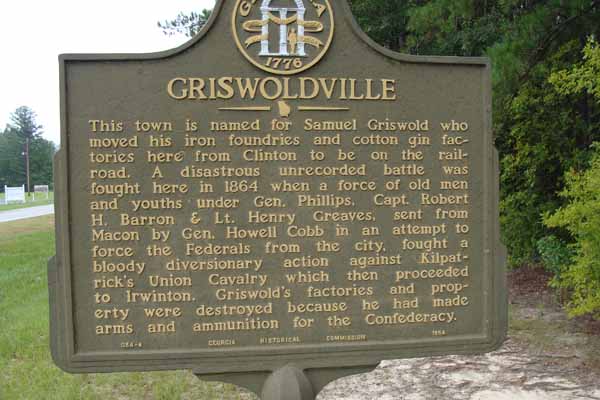
This week’s #MarkerMonday looks at the Griswoldville historical marker in Jones County. This historical marker is one of several that follow the history of the Battle of Griswoldville. The battle took place on November 22, 1864, two days after Sherman’s Right Wing destroyed the small factory village of Griswoldville. As Confederate Brigadier General P.J. Phillips began moving his command, the 1st Division (Georgia Militia and attached units), through what was left of Griswoldville, he heard a battle taking place about a half mile east. He found other Confederate troops—Major Ferdinand Cook’s Athens and Augusta battalions—engaged with U.S. soldiers under General Charles C. Walcutt (US) which, after retiring from Griswoldville, had taken up a strong position behind Little Sandy Creek. After the battle the 650 Confederate casualties, made up almost entirely of teenage boys and greying men, outnumbered the US casualties about six to one.
In 1820, Samuel Griswold from Connecticut opened Georgia’s first iron foundry upon his arrival in Clinton, the county seat of Jones County. By 1849, his manufacturing operation was continuing to expand, so he moved his cotton gin manufacturing plant, sawmill, and grist mill from Clinton to the southern portion of county near the railroad. After relocating his factories, creating a stop on the railroad, and building additional public structures, such as a church and shops, Griswold named the new small town Griswoldville. During the Civil War, Griswold adjusted his manufacturing plant to produce firearms, ammunition, and other metal necessities for the Confederate soldiers.
Griswoldville’s involvement in the war made it a target during the March to the Sea. On November 20, 1864, the 9th Michigan Cavalry, led by Captain Frederick Ladd, tore through Griswoldville. They destroyed the railroad and station, soap factory, candle factory, pistol factory, and all prepared supplies, before setting the small town on fire. The 9th Michigan Cavalry was followed by Colonel Eli Murray’s 1st Cavalry Brigade on November 21, who further damaged the barely standing buildings and railroad tracks before setting the town on fire for a second time.
Explore the links below to learn more:
Related Marker Text - Battle of Griswoldville
Related Marker Text - Battle of Griswoldville (2 miles NE)
Related Marker Text - Battle of Griswoldville (4 miles E)
Related Marker Text - Battle of Griswoldville (7 miles SW)
Related Marker Text - Samuel Griswold Iron-Master
Related Marker Text - Battle of Griswoldville: The Deployment and Assaults
Related Marker Text - Battle of Griswoldville: The Advance From East Macon
Related Marker Text - Battle of Griswoldville: The Big Picture
New Georgia Encyclopedia - Griswoldville
New Georgia Encyclopedia – Jones County
The Georgia Historical Quarterly has published articles relating to Griswoldville which can be accessed on JSTOR. If your library does not have access to JSTOR, you can go to www.jstor.org and create a free MyJSTOR Account.
"All That Devils Could Wish For:" The Griswoldville Campaign, November 1864
